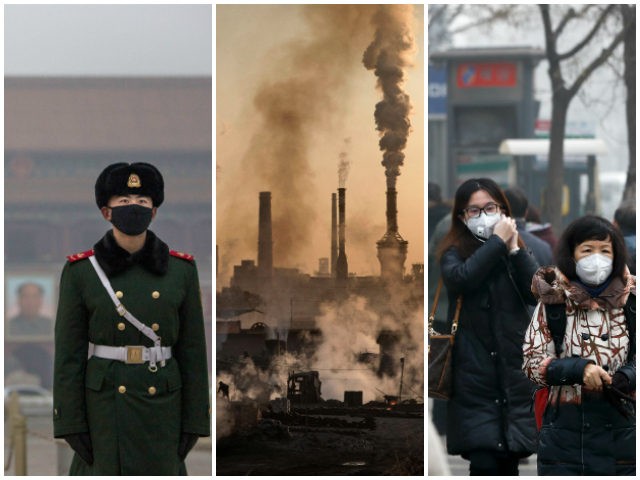Many of the stories on radio, television, and in print issued following President Donald Trump’s decision to pull the United States out of the costly Paris climate agreement claimed America’s absence from the accord means China has ascended as one of the world’s leaders in the battle against human-caused climate change.
Indeed, just hours after Trump’s announcement, at a summit aimed at promoting closer economic ties between China and the European Union (EU), Chinese Prime Minister Li Keqiang and the president of the European Council, Donald Tusk, stood proudly before a multitude of reporters to denounce Trump’s decision and announce Europe and China would forge ahead with the Paris climate agreement.
Good luck with that!
The United States has led the world in reducing greenhouse-gas emissions, and it wasn’t due to regulations or the Paris climate agreement. The natural-gas revolution—which has largely been made possible by fracking, a process demonized by many of the same people who support the Paris agreement—has significantly cut carbon-dioxide emissions. Over the past decade, CO2 emissions have fallen by more than 12 percent. This incredible decline should continue in future years, too, because natural-gas-related companies and products are improving their efficiency daily.
By contrast, China’s CO2 emissions surpassed U.S. emissions 15 years before they were expected to (more than a decade ago). China is now, by a substantial margin, the largest emitter of greenhouse gases in the world.
It’s true China’s per-capita emissions are declining, but that happens in virtually every country whose citizens experience the kind of higher personal income levels we’re now seeing in China, because people become more willing to pay for costlier environmental amenities as they gain access to more wealth.
Because economic growth in China has slowed considerably and to limit its horrific air pollution problems, China is reducing the rate at which its coal use has grown in recent years, but it is not reducing total coal use or its carbon-dioxide emissions. China has also significantly reduced its state-established targets for new solar installations, diverting the solar panels previously slated to be used in the domestic market to the export market, flooding Europe and the United States with below-cost solar panels that have put many domestic manufacturers out of business.
Additionally, it’s worth noting China regularly takes its massive wind farms offline during times of low demand for electricity, and it has built many turbines that are not even linked to the grid, generating power that ends up getting distributed to no one. These turbines are similar to China’s ghost cities, many of which were built to artificially drive economic growth. They still dot the Chinese countryside, uninhabited and falling into disrepair. It should be remembered all those ghost wind turbines and cities required a lot of concrete, steel, and fossil fuels to construct—adding to China’s carbon-dioxide emissions.
China is also promoting the construction of coal-fired power plants across the globe, building or financing large plants on the African continent and in India, Indonesia, Iran, Mongolia, Pakistan, Turkey, and Vietnam. China is exporting its carbon-dioxide emissions, allowing it to escape much of the blame regularly hurled by environmentalists at governments believed to be destroying the planet.
Under the terms of the Paris accord, China doesn’t have to agree to cut its emissions. In fact, China admits its emissions will peak by at least 2030. But what matters is not when they peak but the level at which they do so. If they peak at double or quadruple what China’s carbon-dioxide emissions are today, then all the emissions cuts made by the rest of the world won’t offset the contributions made by China to the globe’s total carbon-dioxide concentration level.
Indeed, the sham marriage between China and the European Union over the Paris climate agreement lasted less than a day—even shorter than the nine days it took for Cher to file for divorce from Gregg Allman!
China scuttled the proposed joint communiqué that would have been issued by it and the European Union announcing their planned climate cooperation, because the Chinese government had serious disagreements about trade issues, including the European Union’s refusal to drop its World Trade Organization investigations into allegations China has been dumping below-cost steel into European markets. As with so many of the climate disasters hyped by alarmists, the planned joint commitment to the Paris climate agreement ultimately failed to materialize because national priorities overcame joint action.
How can the largest emitter of carbon dioxide in the world—one committed to growing emissions for the foreseeable future—be a leader in emissions reductions? It can’t. The environmentalists and global bureaucrats propagating such a notion are, at best, engaging in wishful thinking that is motivated by their hatred of Trump. Americans should reject this hogwash!
H. Sterling Burnett, Ph.D. (hburnett@heartland.org)is a research fellow on energy and the environment at The Heartland Institute, a nonpartisan, nonprofit research center headquartered in Arlington Heights, Illinois.

COMMENTS
Please let us know if you're having issues with commenting.